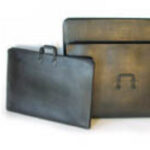If you are longing for warm spring weather to come so that you can get to those vegetable or flower gardens, this is a good way to spend the long winter hours. You’ll have a jumpstart on your spring and summer gardening by planning and organizing through the winter months.
Buy an inexpensive date book planner for the coming year. Either buy a zippered 3 ring binder, or swipe one that your kids have discarded. You might even want to buy a Farmers Almanac to add to your gardening portfolio. Fill your binder with paper and some dividers.
You can use this binder and date book to keep all of your gardening plans organized and ready to use. Setting it up will depend on the projects you have in mind for the coming season. Draw up a sketch of your yard. You don’t have to be an artist; you know what your yard looks like!
You can even sketch all of your flower beds individually and separate them with the dividers. Label one divider for your vegetable garden, if you plan to have one. Label one for supplies, or things you need to buy. If you need new garden tools add them in this section. Think about the condition your gardening tools are in, or inspect them visually if you can. If your spade looks a little rough, make a note to replace it.
Use your flower bed sketches to plan out what kind of flowers you want to plant in the different flower beds in your yard. List each flowers or plant on its own page. You can use these pages to take notes on as you do research on the specifics of these flowers. You can even find pictures of flowers you like on the internet and print them to save in your garden planner.
Use the date book and the Almanac to help you keep track of best planting days, when to fertilize the plants and flowers, or even the date you plant them. You can even have a section to keep a list of your favorite on line gardening sites, or ordering centers. Arrange the binder in whatever fashion works best for you.
The point is you’ll be well ahead of the game when planting time comes. If you start ordering flower seeds, you can also slip them into the pockets of your binder and you’ll never have to wonder where in the world you have put them!
Work on your binder whenever you have a little extra time, or are looking for a way to break up the winter doldrums. It may be snowing and cold outside, but you can loose yourself in a world of beautiful flowers, just by browsing through your garden planner and adding more pictures or research.
Many online sites offer seed and flower catalogues that you can order. Sometimes they just come in the mail. You can also stick these in your garden planner binder, and you won’t loose them or throw them away by accident.
Plan your vegetable garden in its own section. List the different vegetables you want to plant, and draw yourself a full page area for your planting guide. This way you can research what grows best by what and what plants shouldn’t be too close.
When spring comes, you will be well organized and ready to dive right into planting your flowers, plants or vegetables. All you have to do is check the notes and drawings you have already done. You’ll be out there in the warm sun planting, while others are still running around gathering and organizing!
Keep your binder up to date and handy. When you have finished with that years planting and gardening you’ll be able to use it as a reference when you work on the following years plans during the winter months again!
Experiment with your own Garden Planner Guide and set it up any way that fits best for you. By the following year, you’ll probably change it around, add different sections, or a variety of other ideas that you will come up with.
Here are a couple of sites to get you started:
www.gardenguides.com
www.thegardenhelper.com

